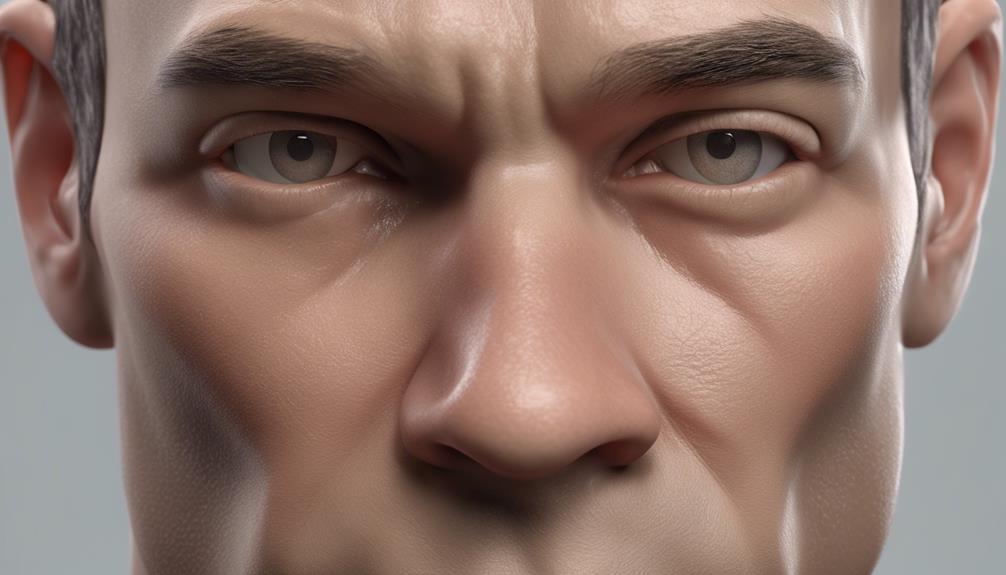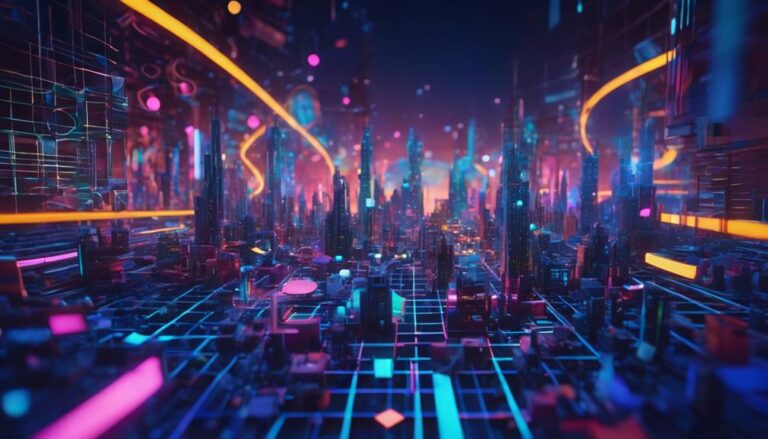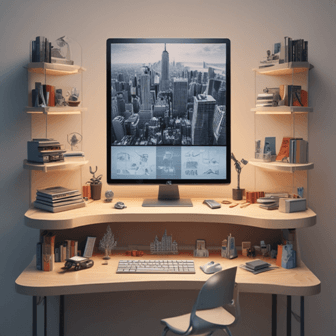What Makes 3D Style Models So Believable?
When creating highly believable 3D style models, you combine advanced techniques like volumetric lighting and ambient occlusion to capture subtle variations in texture, reflectivity, and transparency. High-resolution surface details and realistic material properties are also crucial in replicating real-world environments and interactions. Techniques such as normal mapping, displacement mapping, and physically-based rendering enhance appearance, while high-fidelity visuals are achieved through detailed texturing and shading techniques. Additionally, physics and motion simulation, artistic attention to detail, and high-resolution geometry creation all play a role in making 3D models more believable, and there's even more to it than that.
Key Takeaways
- Advanced lighting techniques, such as volumetric rendering and ambient occlusion, enhance visual fidelity and immersion.
- Realistic material properties and high-resolution surface details accurately replicate light interaction with various surfaces.
- High-fidelity geometry creation and optimization techniques capture micro surface structure and nano details.
- Physics and motion simulation enable lifelike interactions and dynamic environmental awareness.
- Artistic attention to detail, including material accuracy and color palette consistency, crafts a cohesive experience.
Advanced Lighting Techniques
When implementing advanced lighting techniques in 3D style models, accuracy is key. You'll want to consider the interplay between light sources, materials, and the environment to create a believable scene.
One technique to achieve this is volumetric rendering, which allows you to simulate the way light interacts with particles in the air, such as dust, smoke, or fog. By accurately modeling the way these particles absorb and scatter light, you can create a more immersive and realistic environment.
Another crucial aspect of advanced lighting is Ambient Occlusion (AO), which simulates the way objects block and absorb ambient light.
By using AO, you can create subtle shading and depth cues that enhance the overall realism of your model. To implement AO effectively, you'll need to consider factors such as object proximity, material properties, and lighting intensity.
Detailed Texturing and Shading
When creating detailed textures and shading in 3D style models, you'll want to focus on realistic material properties that accurately replicate the way light interacts with various surfaces.
By applying advanced lighting techniques, you can further enhance the model's visual fidelity and create a more immersive experience.
To achieve this level of realism, you'll need to incorporate high-resolution surface details that take into account subtle variations in texture, reflectivity, and transparency.
Realistic Material Properties
Realistic material properties are key to creating believable 3D models, and detailed texturing and shading play a crucial role in achieving this goal.
To achieve material authenticity, you'll need to accurately replicate the physical properties of various materials, such as metal, wood, or fabric.
This involves understanding the intricate interactions between light, texture, and material properties.
When creating detailed textures, you'll need to focus on subtle variations in color, pattern, and roughness to achieve visual accuracy.
For instance, when texturing a metal surface, you'll want to capture the subtle nuances of reflectivity, roughness, and anisotropy.
Similarly, when shading a fabric surface, you'll need to simulate the complex interactions between light, texture, and weave pattern.
Advanced Lighting Techniques
Advanced lighting techniques play a crucial role in bringing your 3D models to life, and mastering detailed texturing and shading is essential to achieving photorealistic results.
When done correctly, advanced lighting techniques can add depth, dimension, and emotion to your 3D models.
Some key techniques to focus on include:
- Ambient Occlusion: This technique simulates the way ambient light is blocked by the geometry of your model, creating subtle shading and depth cues.
- Volumetric Lighting: This technique simulates the way light interacts with particles or fog in the air, creating a more immersive and realistic atmosphere.
- Specular Mapping: This technique allows you to control the way light reflects off the surface of your model, creating a more detailed and realistic appearance.
- Diffuse Shading: This technique simulates the way light scatters across the surface of your model, creating a more subtle and nuanced appearance.
High-Resolution Surface Details
To achieve high-fidelity visuals in your 3D models, you'll need to focus on high-resolution surface details, which involve detailed texturing and shading techniques.
High-resolution surface details allow you to capture even the smallest nuances of a material's appearance, such as its micro surface structure and nano details. By incorporating these details, you can create 3D models that exhibit a high level of realism and accuracy.
Detailed texturing techniques, such as normal mapping and displacement mapping, enable you to create complex surface geometries and patterns.
Normal mapping simulates the micro surface structure of a material, while displacement mapping generates actual geometric detail. Shading techniques, such as physically-based rendering (PBR), further enhance the appearance of your 3D models by accurately simulating the way light interacts with different materials.
Physics and Motion Simulation
To create believable 3D style models, you'll need to simulate realistic character movement and dynamic environmental interaction.
This involves integrating physics engines that can accurately model character locomotion, balance, and collision response.
Realistic Character Movement
Realistic character movement in 3D style models relies heavily on physics and motion simulation to create lifelike interactions between characters and their environments.
You'll notice that characters don't just move – they react to their surroundings and each other in a way that's eerily realistic. This is made possible by advanced physics engines that simulate real-world motion.
To achieve this level of realism, developers use various techniques, including:
- Motion capture: Recording real actors' movements and translating them into digital data, allowing for incredibly lifelike performances.
- Kinetic analysis: Breaking down complex movements into smaller components, making it easier to simulate and animate them accurately.
- Physics-based animation: Using algorithms to simulate the way objects and characters move and interact, creating a more immersive experience.
- Simulation-based animation: Allowing characters to adapt to new situations and environments in a more realistic way.
Dynamic Environmental Interaction
While creating immersive experiences, developers are constantly striving for dynamic environmental interaction, where characters seamlessly interact with their surroundings.
This feature is crucial in 3D style models, as it enhances the believability of the digital world. You achieve dynamic environmental interaction by incorporating physics and motion simulation into your model.
This allows characters to respond realistically to their environment, taking into account the laws of physics and gravity.
When you integrate physics and motion simulation, you enable object manipulation and environmental awareness.
Object manipulation refers to the ability of characters to interact with objects in their surroundings, such as picking up items or moving furniture.
Environmental awareness involves the character's ability to perceive and respond to their environment, including avoiding collisions with objects or navigating through complex spaces.
Realistic Material Properties
Most 3D models rely on accurate representations of material properties to convincingly simulate real-world interactions.
Material authenticity is crucial in creating believable 3D style models, as it directly affects how objects interact with their environment.
For instance, the way light reflects off a surface can make or break the illusion of realism.
To achieve realistic material properties, you should focus on the following key aspects:
- Surface Reflection: Accurately modeling the way light reflects off various materials, from smooth metals to rough, organic textures.
- Specular Mapping: Creating detailed maps that define the specular highlight's size, shape, and intensity to enhance material authenticity.
- Normal Mapping: Simulating the fine details of a material's surface geometry to create realistic lighting interactions.
- Translucency and Transparency: Modeling the way light passes through or scatters within materials, such as glass or skin.
High-Resolution Geometry Creation
You've established a solid foundation with accurate material properties, capturing the subtleties of how objects interact with their environment. Now, it's time to focus on high-resolution geometry creation, which plays a crucial role in making 3D style models believable. This process involves creating detailed, intricate models that accurately represent real-world objects.
Geometry optimization techniques are essential in achieving high-resolution geometry creation. These techniques enable you to refine your mesh, reducing the number of polygons while maintaining the overall shape and structure of the object.
| Geometry Optimization Technique | Description |
|---|---|
| Mesh refinement | Subdivides the mesh into smaller, more detailed polygons |
| Polygon reduction | Reduces the number of polygons in the mesh while preserving the overall shape |
| Normal mapping | Stores detailed surface information in a texture map |
| Displacement mapping | Stores height information in a texture map |
| Subdivision surface modeling | Creates smooth surfaces by subdividing the mesh |
Artistic Attention to Detail
Every detail in your 3D style model can significantly impact its overall believability and aesthetic appeal.
As you focus on artistic attention to detail, you're not just adding visual noise – you're crafting a cohesive and immersive experience.
To achieve this, you'll need to balance various elements that contribute to the model's overall sense of authenticity.
When it comes to artistic attention to detail, consider the following key aspects:
- Brush stroke authenticity: Ensure that your texture maps and normal maps accurately represent the way light interacts with the model's surface. This will help create a sense of realism and depth.
- Color palette consistency: Establish a well-defined color scheme and stick to it. This will help maintain visual cohesion and prevent the model from feeling disjointed.
- Material accuracy: Research and accurately depict the materials and textures that make up your model. This will add a layer of realism and help the model feel more tangible.
- Environmental context: Consider the environment in which your model will be placed. This will help you make informed decisions about lighting, textures, and overall aesthetic.
Frequently Asked Questions
Can 3D Models Be Used in Non-Visual Applications?
You're using 3D models in non-visual applications, like data analysis and virtual training, where they can be leveraged for simulations, decision-making, and skills development, offering immersive experiences beyond visual representation.
How Do 3D Models Handle Extreme Weather Conditions?
When handling extreme weather conditions, you simulate climate scenarios using physics-based weather simulations, incorporating variables like wind, precipitation, and temperature to test your 3D models' durability and performance under realistic environmental stressors.
Are 3D Models Used in Historical Event Reenactments?
When recreating historical events, you use 3D models to achieve event accuracy and historical authenticity, often incorporating detailed textures, accurate lighting, and precise architectural models to bring the past to life with precision and realism.
Can 3D Models Be Used for Educational Purposes Only?
You can utilize 3D models for educational purposes, creating immersive virtual labs and interactive simulations that enhance student engagement and understanding of complex concepts, allowing for hands-on experimentation and real-time feedback in a controlled environment.
Are 3D Models Used in Architectural Preservation Efforts?
You're likely to find 3D models in architectural preservation efforts, where they're used to create digital archives and help conserve cultural heritage sites by accurately documenting their original structures and conditions over time.
Conclusion
As you've seen, the culmination of advanced techniques makes 3D style models incredibly believable. By combining cutting-edge lighting, detailed texturing and shading, physics and motion simulation, realistic material properties, and high-resolution geometry creation, artists can craft highly realistic digital representations. Attentive artists then refine these models with precise details, yielding immersive experiences that blur the line between digital and reality, drawing you in with uncanny accuracy.







